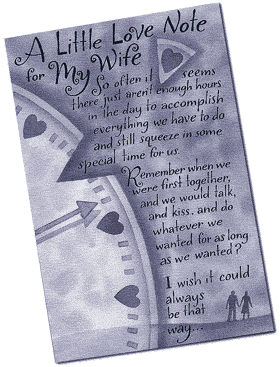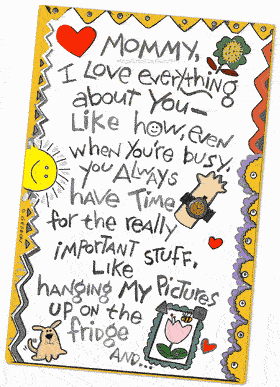|
Trips to the mailbox are happier
because of Nicole Fraser’s work. As a greeting card writer
at American Greetings in Cleveland, Ohio, Nicole has been a
part of millions of birthdays, special occasions, and
everyday hellos. "I use my creativity to bring people
closer together," she says. "That’s a great
feeling."
Greeting card writers help people express thoughts and
sentiments. "Greeting cards have to feel very personal,
as if the words apply to you specifically," says
Nicole. "But they also have to feel very personal to
thousands of other card shoppers." To accomplish this
feat, writers look for emotions many people share, such as
the feeling of freedom after graduating from school.
Card writers like Nicole usually write to fill a specific
request. Their editors tell them the types of cards the
company needs, such as cards for a birthday or a Mother’s
Day line. Editors give writers information about the card’s
sender and receiver, including details about their ages,
genders, and relationship to each other.
To find common themes to write about, Nicole follows the
latest cultural trends. She reads modern poetry, looks
through magazines and comic strips, and skims popular
novels, including Oprah’s Book Club selections—all of
which are in her company’s library. Other card writers in
her office read sociology and psychology books and watch
television shows. "We have to know the language people
are using today," she says.
Nicole often writes short, pithy phrases or other pieces
of prose, but her favorite style is greeting card poetry.
"I love writing long verse," she says. "I
like the challenge of finding just the right word to match
the rhyme and meter. It’s like a puzzle." What makes
the challenge even greater is that the poetry has to sound
conversational and modern. "We don’t want anything
stilted or sing-songy," says Nicole.
Greeting card writers choose their prose to fit the
sender, whose style of speech is often different from their
own. "One of the hardest things for me to learn was how to write for
male card senders," Nicole says. "There are some
words that men typically don’t use in conversation, like
‘treasure,’ ‘joy,’ or ‘precious.’" For
teenagers, Nicole might use slang; for younger people, she
uses short, simple words. All writers learn the speaking
styles of different types of people in different situations.
of the hardest things for me to learn was how to write for
male card senders," Nicole says. "There are some
words that men typically don’t use in conversation, like
‘treasure,’ ‘joy,’ or ‘precious.’" For
teenagers, Nicole might use slang; for younger people, she
uses short, simple words. All writers learn the speaking
styles of different types of people in different situations.
As she writes, Nicole identifies the feelings the sender
will want to express. "You have to understand and care
about people and make sure that comes through in your
writing," she says.
Nicole usually spends between a day and a week working on
each card, but she develops some card concepts over months.
And in a pinch, she can finish a card in an hour.
Even after working to find the perfect words, however,
card writers might never see their original text in print.
They submit their work to editors who make or recommend
changes. Being open to these changes is part of the job.
"This isn’t a career for writers who are too
protective of their writing," says Nicole. "Lots
of people will make suggestions and change your work."
Sometimes, suggestions from others make finishing a card
easier and more fun. In Nicole’s company, as in most large
card companies, writers brainstorm for inspiration. Humor
card writers spend much of their time building on each other’s
ideas and jokes. To make collaboration easier, writers work
in cubicles arranged in a bullpen configuration or migrate
to common sitting areas. But writers can also retreat to
quieter areas while composing.
When they’re not working on a particular card, writers
are experimenting with new styles or different types of card
senders. They work with marketers, editors, and graphic
artists to create additional card lines.
Some innovations require an entirely different kind of
writing. Computerized cards, for example, are meant to be
adjusted and personalized by the sender. Writers give
senders options by composing flexible verses. Other writers
create electronic cards, which are short and often are
paired with animation, for sending over the Internet.
According to the Bureau of Labor Statistics, at least 210
salaried employees wrote and designed for greeting card  companies
in 1999; they earned an average of $36,620. Many more
greeting card writers worked as freelancers, self-employed
workers who sold their work to greeting card publishers for
a fee. The Bureau does not have data on these writers. But
according to industry sources, most work part time and earn
an average of about $60 a card. Larger companies pay between
$100 and $150 a card. companies
in 1999; they earned an average of $36,620. Many more
greeting card writers worked as freelancers, self-employed
workers who sold their work to greeting card publishers for
a fee. The Bureau does not have data on these writers. But
according to industry sources, most work part time and earn
an average of about $60 a card. Larger companies pay between
$100 and $150 a card.
Many card writers begin as freelancers. Nicole is one
example. After studying English in college, she worked in
another field and wrote cards in her spare time. Freelancers
call greeting card publishers to find out what types of
cards they need and then send appropriate drafts. Nicole got
her current job by sending American Greetings a writing
portfolio that included copies of her freelance work. Other
greeting card writers begin their careers as proofreaders or
interns at card companies.
People who want to become greeting card writers can have
any college major, according to Nicole. Her fellow writers
have degrees in subjects ranging from advertising to
theater. But, she says, every aspiring writer should attend
creative-writing seminars and classes and watch for modern
trends. "Don’t copy what’s already been done,"
she says. "Think about what you and your friends want
to say to each other right now. Your ideas are the future of
the industry."
Images courtesy of Nicole
Fraser and American Greetings
 Top Top
|



